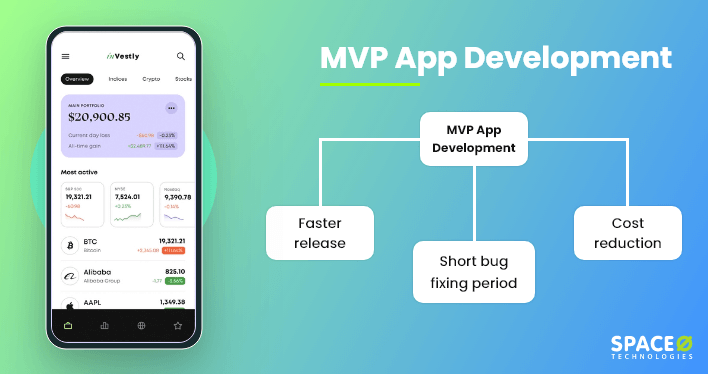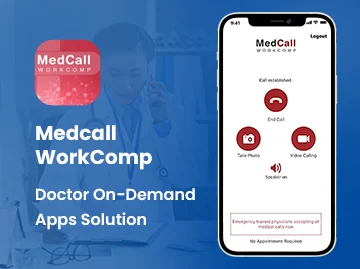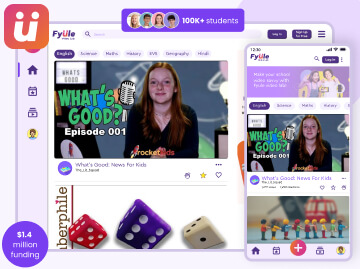Launching a successful app does not imply building every feature right away. To get your full-fledged product in the market, you must strike a balance between speed, budget, and quality while assessing whether it resonates with the users.
With MVP development, you can start small to reach big. In simpler words, you can test your idea with core features, get feedback, and attract adopters without having to develop a full-fledged product in the initial phase.
This blog walks you through the essentials of MVP app development—the process, benefits, cost, timeline, and more. Whether you are a startup, entrepreneur, or an individual with an idea, we have covered complete information for MVP app development to help you get started with your app.
Table of Contents
What is an MVP in App Development?
A Minimum Viable Product or an MVP app refers to the basic, minimal version of a mobile app developed with only the essential features and functionalities.
Effective MVP planning is the foundation of successful app development, ensuring you prioritize core features that address user needs while staying within budget and timelines. After the MVP app launch, you can keep enhancing the app features based on real-world feedback to ensure the product meets customer demands.
In instances where you have an app idea in mind and want to move forward with its MVP version, reaching out to an experienced MVP development company can help you better. Such agencies can help you build your MVP app and even scale it to a full-fledged version.
For example: Zappos
To test the business idea, the founder Nick Swinmurn, created a simple website under the domain of shoesite.com and identified the market viability of the product. He didn’t buy the items at first. Instead, he waited to see if someone would order the shoes from the webpage. Only then would buy the shoes, and send them to his customers. However, the idea turned out to be successful.
Why Build an MVP?
Developing a full-scale mobile app can be overwhelming due to the complexities involved in the development process. These complexities include excessive features, high-end visuals, and extensive development timelines. MVP app development is a strategic approach to overcome these challenges.
With MVP development, you can test your ideas and learn more about your target audience. By focusing on developing an MVP app, you can decide whether to take a sequential step or to change the direction based on user feedback.
This saves significant time and resources that would otherwise be utilized in full-scale app development. Let’s explore the benefits of developing an MVP app.
4 Benefits of Building Minimum Viable Product
- MVP app development prioritizes the most essential features of the app that deliver value to users. This clarity helps to create a streamlined and user-centric product.
- Launching your MVP app earlier helps you to gain a competitive edge by giving early-bird benefits. Additionally, gaining user feedback allows you to iterate the app accordingly without waiting to develop all the features.
- By launching your MVP app in the market, you can minimize the risk of developing a product that might not resonate with the target audience. It allows you to get proper insights on whether to move ahead with the product or not.
- Developing an MVP requires fewer resources and results in cost savings compared to a full-featured app. By focusing on core features and functionalities you can save investment of time and money while also testing your idea in the market.
Now let’s quickly discuss how to build an MVP application. In the following section, we have shared a step-by-step mobile app development process that you can consider to build an MVP for your business.
5 Steps to Develop a Successful MVP App for Your Business
This MVP development process is a part of agile methodology. Agile is a software development framework which follows an incremental approach to software development. A well-executed MVP development process not only accelerates time-to-market but also provides invaluable insights for future product iterations. Therefore, considering these steps will help you identify and prioritize app features for your app so that you confidently deploy your MVP in the market.
Understand Your Business Needs and Market Demands
Being a startup owner or an entrepreneur, you must identify if there is actual demand for your product or not. For example, it could be for your own organization to streamline the work process, or you might want to bring your business online to boost revenue.
Finding an app idea is not enough; you also need to analyze what your competitors are doing and how you can actually make an impact through your product. This will give you a better understanding of how your mobile app will help the end users and how you can succeed.
Determine the Long-term Goals to Build an App
If you see an opportunity for your product and determine its requirements in the market, then you need to set a long-term business goal to go ahead in scaling the application with more advanced features.
- Determine what you are planning to achieve
- Look for revenue-generating opportunities for your app
- Plan how you can make a brand for your business
Define the Success Criteria for Your Product
After deciding the goals, you need to set some of the mobile app KPIs to define the success of your product. You need to track and analyze the results and determine whether the app is really performing well in the market or not.
Looking to build an MVP on a budget? Let us help you!
Space-O, a top US mobile app development company with 200+ experienced developers who have built over 4400 apps.

Map Out the User’s Journey
When you develop an MVP for startups, you will have to constantly add new features to the app. It is essential that you think multiple times in mapping out the user journey. Keep the UI in your mind and understand how your target users will interact with your app.
The best recommendation to make an app successful is to create an app UI that is simple and easy to navigate. Mapping out the user flow will help you plan how you can make it easy for the users, from beginning with opening the mobile apps to completing a successful task.
Identify Your Users to Create a User Journey
The simple way to identify your users is to find who would take an interest in your product or services. Or check your competitors to understand who is using their apps and try to collect information like demographics, gender, age limit, and interests.
Identify the Actions of the Users
The actions are something that a user will take to achieve a goal. So, you need to identify the ways in which a user can achieve their goals. However, most importantly, you will need to ensure that you are adding a lot of opportunities for you to increase the conversion rate.
Identify the Story Endings
Every user has a different story ending, so you need to ensure at which stage they might stop using the app. For instance, the buyer is only using the app to compare the prices of the dress or might really want to order it through your platform.
Let’s understand this whole layout of mapping the user flow through the table below.
Target Users Actions Story Endings Buyer - Find a dress on the app
- Add it to the cart
- Fill in all the required details
Make the payment and purchase the dress Create a Gain and Pain Map
This is one of the essential stages that you can’t skip in MVP mobile app development. Moreover, a gain and pain map is also essential for MVP validation—which is determining whether or not your MVP idea is an ideal product-market fit. In this stage, you will need to create a gain and pain map for each action that a user will take. This will help you identify how much effort your users are putting into taking action and what gain they achieve when each action is addressed.
This will help you determine where you need to add value to the app through better features and functionalities. The best way to organize the gain and pain points is to create a chart. Have a look at what a pain and gain map should look like.
Pains Actions Gains Want to compare the prices of different dresses Compare products, add to the cart, and make a purchase Buy one dress after a comparison Decide on the App Features
An MVP is a continuous app development process where you test your business concept by integrating limited yet essential features which would be helpful for the early adopters. This stage is very crucial because you will need to decide on the features for your app along with the features which have lower priority.
Here are some of the questions that you need to ask yourself before deciding on the features:
- What do users want from my app?
- What challenges are my users facing?
- What solutions are my users looking for?
Ensure that you only add limited features at one go. This is the actual purpose of developing an MVP, as you could try your ideas with limited resources, budget, and time. You can even hire dedicated app developers who have experience of developing MVP applications as per your business requirements.
Build, Launch, and Test Your MVP
Up to these steps, you get to learn about your target user base and their pain and gain points and validate your app idea to lay the foundation for the MVP roadmap.
Now, you need a reliable app development consulting company who can guide you to develop an MVP tailored to your business needs. Coordinate with the development team and focus on getting your MVP to market as soon as possible.
After launching your MVP app on the app stores, collecting user feedback from diverse demographics is crucial to understanding their needs and refining the product. Through MVP testing, you can gather real-time user insights, identify bugs in the initial product, and refine your solution to meet the early adopters’ expectations.
Finally, MVP validation confirms if the core idea addresses the intended problem and determines whether the product has achieved market fit before scaling further.
Want to know the process of launching an app? Here’s a complete guide about how to launch an app on iOS and Android.
Also, you will get to know where you need to improve your product and what is most liked by the app users.
An MVP is a part of the continuous process where you build a product, launch it, and test it again until you completely build a full-fledged product.
However, there could be different goals behind launching an MVP. Your requirements would also differ based on your mobile app idea. So, let’s understand how much you would need to invest in building an MVP.
How Much Time Does It Take to Create an MVP App?
The timeline it takes to build a minimum viable product App is 1 – 3 months.
Using the agile methodology, if we build an MVP, then let’s see how much it would take based on different app development stages.
| MVP App Development Stage | MVP App Development Timeline |
|---|---|
| Business Analysis and Market Research | 1+ Week |
| Business Plan Creation | 1+ Week |
| MVP app Design | 2+ Week |
| MVP Mobile App Development & Testing | 12+ Week |
| Product Launch | 2+ Days |
Estimating an MVP application development timeline entirely depends on your requirements for the app, whether you are simply integrating one feature or more features.
It also depends on the complexity of the app, the usage of the third-party APIs and plugins, and the UX/UI design.
Choosing the right development partner can significantly impact the efficiency and quality of your MVP. An MVP development company speeds up the process by using pre-built frameworks, reusable components, and efficient resource allocation.
If you’re looking for experienced teams that can help you build a quality product faster, we have prepared a list of top MVP development agencies that can assist you in your MVP product launch.
Now, let’s see how much it would cost you to build an MVP App in the next section.
How Much Does It Cost to Develop an MVP App?
The cost of app development range varies because several variable factors are involved in developing a minimum viable product. For more cost breakdowns, check out the detailed guide on how much it costs to build an MVP .
The most important factors include the following:
- The scope of product design and development task
- The technology stack that you use
- Hourly charges of the MVP App developers
- The usage of the third-party services
- The features and functionalities you add to the app
However, we will now check the MVP app development cost based on different app types. Have a look at the following table.
| MVP App Type | MVP App Development Cost |
|---|---|
| eCommerce App | $20,000 – $23,000 |
| Travel App | $25,000 – $30,000 |
| Diet & Nutrition App | $18,000 – $23,000 |
| Dating App | $15,000 – $18,000 |
| On-demand App | $16,000 – $26,000 |
| Social Media App | $24,000 – $30,000 |
| Real Estate App | $20,000 – $25,000 |
| Weather App | $12,000 – $15,000 |
We have extensive experience in building MVP apps for healthcare , e-commerce, real estate and other MVP solutions for clients across the globe, spanning various domains such as on-demand services, dating platforms, and weather applications.
If you are interested in how to build an MVP leveraging some of the best techniques, then you need to look at the following section for this.
Which are the Top MVP Development Techniques?
In this section, we are basically going to discuss the practices that you can consider for building a successful MVP. Let’s start discussing the MVP app development techniques.
- Conduct market research to identify your target audience
- Identify the estimated MVP app development timeline and cost before starting the project to avoid negotiations later on
- Keep track of users’ demands and identify the more valuable features based on it
- Leverage the current trends in your MVP, but try to keep things simple as much as possible
- Market your app amongst your potential customers to boost sales
Considering all the points will help you build a solution that will give you the expected and the best results.
When is MVP Worth It?
You probably had this question in mind while thinking of an MVP plan for a product. So, to cut to the chase, we have come up with some of the points that will help you find some of the best scenarios when it is worth building an MVP.
When you:
- Want to quickly launch your idea in the market with minimum resources and effort
- Want to test your business concepts and ideas to identify what will work in your favor and what not
- Want to develop a monetization strategy for your product so that you reap maximum benefits
- Are not sure of any particular feature and want to test it in the market and want to enhance the quality of the app
Now, we will check the apps which were once MVPs. This will help you understand how you can take the first step to building a successful, robust, and full-fledged application.
Examples of Companies Who Choose MVP App Development
We will discuss the companies that were once MVPs and see their transformation journey and how they have become a giant now with the right MVP planning. Let’s explore how developing an MVP helped them in their journey to become successful mobile apps in the market.
| App | Use Case | Reviews (Play Store) |
|---|---|---|
 Dropbox | You will be shocked to learn that Dropbox has never launched a physical product before. However, they started out as a demo video MVP to make users aware of the importance of the benefits of storing data in one place. Later, Dropbox got positive responses from the users and actually believed in their idea to launch a successful product in the market. As a result, it acquired more than 1 million users in just 7 months. | 4.3 2.2M Reviews |
 Foursquare | Foursquare was launched with only one feature that let people check in at various locations in order to gain points and badges. However, this app really got famous amongst the users, and then, Foursquare also enhanced its features and has now become a full city guide app for travelers. | 4.1 488K Reviews |
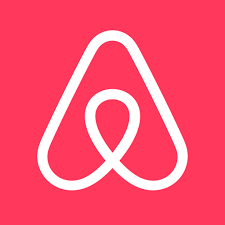 Airbnb | The Airbnb app started as an MVP when its founders realized the challenges of booking hotels in San Francisco. They turned this challenge into an opportunity and started by setting up mattresses in their small room to earn money. Soon, the founders realized the worth of their idea, and now Airbnb is estimated at USD 5.99 billion. | 4.5 1.37M Reviews |
| Facebook is a popular social media application that also started as a basic MVP, known as Thefacebook, that used to connect the students of Harvard. The profiles used to have limited information. However, this idea boomed and proved enough to enhance the app with more app functionalities. Now, it is used by more than 2.93 billion users as of 2022. | 3.1 130M Reviews | |
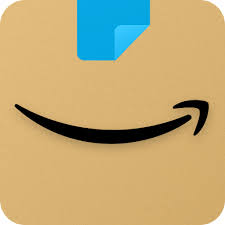 Amazon | Amazon needs no introduction as it is one of the biggest eCommerce leaders in the market. However, very few know that it started as an online bookstore in the 90s. Looking at the bigger picture, Jeff Bezos realized the worth of this opportunity and built an eCommerce solution to sell almost everything through this platform. | 4.5 3.24M Reviews |
We are also going to discuss some of the frequently asked questions in the next section. So have a look at all the questions one by one.
Want to Validate Your MVP Idea?
Contact our senior technical consultants, who have experience validating app ideas and designing the roadmap to build a successful MVP.
FAQ About MVP App Development
How to measure the viability of a product?
To measure the viability of the product, you need to keep these 3 things in your mind:
Market Size: Check for enough space to accommodate new sellers in the market and the room for growth.
Target Audience: Find out whether the potential customers have a discretionary income or not.
Competition: Don’t forget to look for your competitors, as you will need to look up to their strategies, strengths, and weaknesses to make your product stand out in the market.
What is the difference between a prototype and an MVP?
A prototype only evaluates the shape of your mobile app idea and helps you understand the look and feel of the app. On the other hand, an MVP is a fully functional mobile app with essential features that let you test your business vision with the collection of initial user feedback.
What makes a good MVP?
You only make a good MVP when you know that your product has the capability to solve at least one specific problem faced by the intended users. Then, you know that you have just stepped into building a successful product that improves the way to solve users’ problems.
Develop an MVP App for Your Business with Space-O Technologies
We hope that this step-by-step guide has helped you understand the different steps of MVP product development along with the estimated timeline and cost to build an MVP. In addition, you have checked how top giants were MVPs earlier to get some inspiration.
